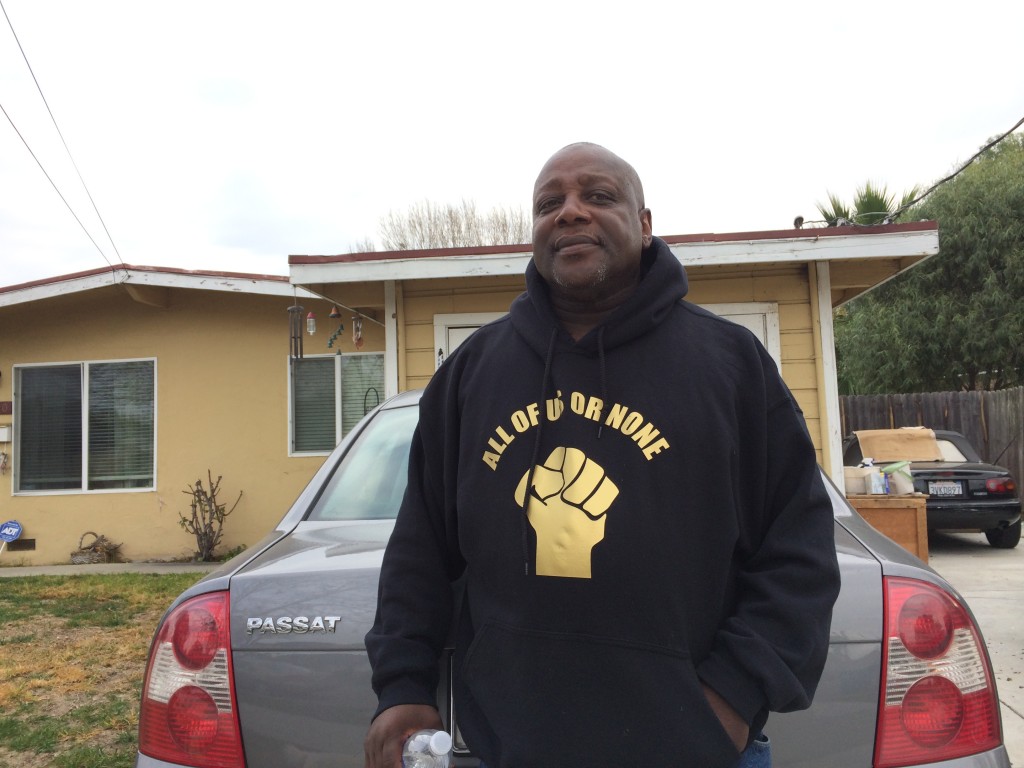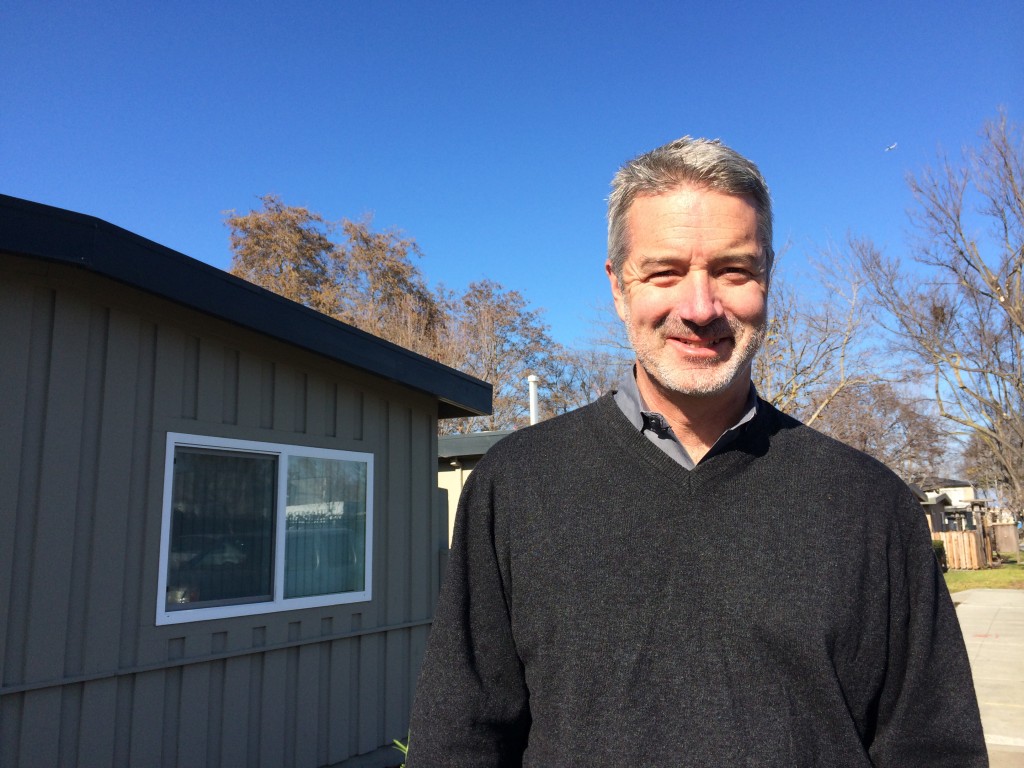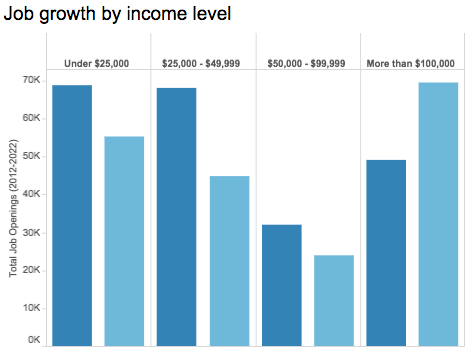Reporter Farida Jhablava Romero’s radio report originally aired on KQED in March 2015.
[dropcap letter=”L”]ike many renters in Menlo Park’s Belle Haven neighborhood, Maria Contreras believes Facebook’s presence here has pushed up rents, making it harder for working-class families to find decent places to live.
Contreras and her husband, who works in construction, saw their rent increase by $200 last November for their three-bedroom house. To afford the $2,700 monthly rent, the couple shares a room with their children and sublets the other two bedrooms. Still, Contreras says her family’s living situation is far better than in years past, when their home was a rented garage without a kitchen or heat.

“It’s very hard. Children don’t have room to play, and one doesn’t have enough space either,” said Contreras, adding that she knows more local families living in similar conditions.
Most garages here are illegally converted to rentals and represent a health and fire hazard, according to city police. But demand is strong and supply is widespread. On a recent afternoon, a bulletin board at a local grocery store down the road from Facebook featured three handwritten ads in Spanish offering garages for rent. Prices go from about $400 to over $1,000, according to the ads, residents and police.
Silicon Valley’s technology-fueled economy is exacerbating a regional housing deficit that is pushing low-income residents particularly to move out of the region to more affordable cities or stay put in tough living conditions. Real estate developers, advocates and residents say a long building hiatus in Menlo Park, the city’s hot real estate market and Facebook’s expansion in Belle Haven — the city’s poorest neighborhood — put enormous pressures on Facebook’s working-class neighbors.
Most of the city’s Latino and African-American residents live in this part of town, east of Highway 101.

“People are seeing their neighbors leave,” said Jennifer Martinez, executive director of Peninsula Interfaith Action, which advocates for affordable housing. “People are seeing investors buy up those properties in the hopes that a Facebook person will come and purchase them for a higher amount of money.”
Facebook’s new extension of its campus in Belle Haven, also called East Menlo Park, is set to open this spring for 2,800 additional employees, some of them looking for housing nearby. The company is Menlo Park’s largest employer and landowner. It’s not uncommon to spot tourists posing for pictures at the company’s thumbs-up “like” sign in front of its headquarters on Bayfront Expressway.
Facebook’s success, with a net income of $2.9 billion last year, has arguably increased nearby property values. Rentals listed on Craigslist and real estate websites frequently tout closeness to Facebook as a plus.
Since mid-2011 when the company moved here, the median rent price for a two-bedroom apartment in Menlo Park rose 42 percent to $3,700, according to the real estate website Zillow. The median home price is $1.6 million and the city is now among the top 10 in the nation with the fastest increasing home values, says a recent NerdWallet report.
A history of inaction
Affordable housing tends to be located in apartment buildings rather than houses. But for over three decades beginning in the 1970s, Menlo Park did not build any large multi-family housing, said Menlo Park City Manager Alex McIntyre.
In 2012, Peninsula Interfaith Action and two other nonprofits sued the city for failing for two decades to comply with a state law which mandates planning for affordable and market-rate housing.
If the lawsuit went to trial, the city would have lost its ability to approve real estate developments — including Facebook’s new campus — and Menlo Park settled, said Richard Marcantonio, who represented the plaintiffs in the case.
The city acknowledges it fell behind in affordable housing — a combination of lack of political will and not enough resources, said City Manager McIntyre, who started the job in 2012, the same year the city was sued.
“To build affordable housing on land that is so incredibly expensive on an economy that’s on fire here, it’s like a double whammy to actually create affordable housing,” McIntyre said.
Since then, following the settlement, Menlo Park updated its housing plan to allow for the potential construction of up to 1,000 affordable units. It also has committed $8.6 million in the last fiscal year towards housing for low-income residents.
The city is reviewing plans to build 372 market-rate apartments that would set aside 5 percent — or 19 apartments — for low-income residents in Menlo Park’s downtown.
“This is really making up for lost time,” McIntyre said. “We are in a housing boom, the needs are very clear.”
Still the breakdown is stark. Most of the 795 apartments under construction are market-rate units in upscale complexes, while just 96 apartments — 12 percent — are slated for low and very low-income residents. Fifteen of those affordable units are being fully subsidized by Facebook.
The company, which bought an adjacent 56 acres of land in February, says it strives to be a good neighbor and listen to the concerns of the community. Facebook’s director of community engagement, Susan Gonzales, says the company has created internships for local students and donated significant funds for local schools and nonprofits.
Facebook also funds the salary of a city police officer dedicated to keeping youth in school and out of gangs. Last year, the company paid for the costs for remodeling and furnishing a new police substation in Belle Haven, right next to its new campus.
Residents’ reaction

Dorsey Nunn, a lifelong resident of Belle Haven, has followed Facebook’s efforts but he isn’t impressed. Its contributions are “crumbs,” he said, noting that the company’s programs to improve public safety and education don’t tackle the main issue in his community: the fast-paced displacement of poor residents.
Nunn is quick to point that it’s not just Facebook’s fault that his neighbors are moving out to more affordable cities over 50 miles away, such as Modesto and Tracy. He also faults poor planning by elected officials and the biting wealth disparities in the region.
“Where is the equity in terms of a multimillion dollar corporation moving to a poor area?” asked Nunn, as he stood on his front lawn down the road from Facebook’s new campus. “Where I live is probably 10 miles from some of the most prosperous corporations in the world. And some of my neighbors will not necessarily make it through college.”
Nunn and advocates such as Jennifer Martinez believe that Facebook — because of its expansion in Belle Haven — could do more to tackle the negative impacts of gentrification, such as contributing to the county affordable housing fund.
“My children and grandchildren will not be able to stay in this community,” Nunn added.
Where will most workers live?
To afford an average two-bedroom apartment in San Mateo County, where Menlo Park sits, a family of four would have to earn about $106,000 annually, according to county estimates.
To afford an average two-bedroom apartment in San Mateo County, where Menlo Park sits, a family of four would have to earn about $106,000 annually, according to county estimates.

But most of the new jobs in the region will pay less than half of that amount. Between 51 and 62 percent of jobs created by 2020 in San Mateo, Santa Clara, San Francisco, Marin and San Benito counties will pay less than $50,000, according to state estimates.
Matt Franklin, former director of the California Department of Housing and Community Development, sees the trend in housing affordability as disastrous for the region’s economy.
“It’s not sustainable for the new jobs created here to be commuting from Tracy or Antioch,” said Franklin, who now leads the nonprofit developer MidPen Housing. “It’s putting all sorts of pressures on the family lives of workers and their budgets, putting pressure on the transportation system and it’s fouling our environment.”
Last year, the city of Menlo Park promised $3.2 million towards MidPen’s project to build 78 affordable units next year in Belle Haven.
“It’s in our economic interest to make these investments,” said Franklin, adding that cities and landowners must increase their efforts. “This isn’t altruism. It’s more than anything an economic necessity. If we are going to have a healthy sustainable economy, we have to find a way to house our workers.”
UPDATE – Editor’s Note (5/29/2015): This story has been updated to reflect that Facebook has subsidized 15 low-income apartments under construction. Peninsula Press had originally reported in March that it was 37 apartments.
CLARIFICATION – Editor’s Note (5/25/2015): Peninsula Press originally misstated that Facebook’s new building had a capacity for 4,000 employees. The capacity is for 2,800 employees.
CLARIFICATION – Editor’s Note (4/3/2015): In this story originally published March 11, 2015, Peninsula Press misstated that Facebook “paid for the construction” of a new police substation. This updated story clarifies that Facebook specifically contributed toward the costs of a remodel and furnishings for the new police substation, not the initial construction of the building. City officials said Facebook’s costs amounted to at least $140,000.
INTERACTIVE: Do salaries in the area size up to the high cost of living?

